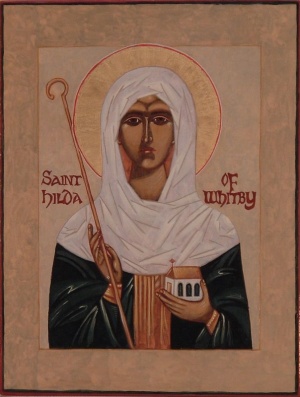Hilda din Whitby: Diferență între versiuni
m |
(traducere) |
||
| Linia 3: | Linia 3: | ||
==Viața== | ==Viața== | ||
| − | Practic tot ce se știe despre Sf. Hilda provine din scrierile venerabilului [[Beda]]. | + | Practic tot ce se știe despre Sf. Hilda provine din scrierile venerabilului [[Beda]]. Ea era fiica lui Hereric, nepotul regelui Edwin al Northumbriei, rege care se pare că ar fi devenit creștin datorită propovăduirii Sfântului Paulin (unul din misionarii veniți de la Roma) în jurul anului 627, pe când Hilda avea treisprezece ani. |
| − | + | Mișcată de exemplul surorii ei Hereswith, care, după ce s-a căsătorit cu Ethelhere din ''East Anglia'' (în prezent ''East of England'', una din cele nouă regiuni ale Angliei) a devenit călugăriță la Chelles, în Galia, Hilda a călătorit și ea în East Anglia, intenționând să-și urmeze sora în străinătate. Dar Sf. [[Aidan de Lindisfarne]] a chemat-o înapoi în Northumbria. După ce s-a [[călugăr]]it, a trăit în [[monahism]] mai întâi la o [[mănăstire]] situată pe malul de nord al râului Wear, apoi la Hartlepool. Ulterior, Hilda s-a angajat să pună în ordine mănăstirea de la Streaneshalch, un loc căruia vikingii danezi i-au numele de [[:en:Whitby Abbey|Whitby]], un secol sau două mai târziu. | |
| − | + | [[Fișier:Whitby Abbey.jpg|thumb|left|200pxl|Abația Whitby]] | |
| − | [[ | + | Under the rule of St. Hilda the monastery at Whitby became very famous. The [[Holy Scriptures]] were specially studied there, and no less than five of the monastics became [[bishops]], St. [[John of Hexham|John, Bishop of Hexham]], and still more St. [[Wilfrid|Wilfrid, Bishop of York]], rendering untold service to the Anglo-Saxon church at this critical period of the struggle with paganism. Here, in 664, was held the important [[Synod of Whitby|synod]] at which King Oswiu, convinced by the arguments of St. Wilfrid, decided, among other issues, a [[paschalion|manner of calculating the date]] for Northumbria's observance of [[Pascha]]. St. Hilda herself later on seems to have sided with Archbishop Theodore against Wilfrid. The fame of St. Hilda's wisdom was so great that from far and near monks and even royal personages came to consult her. Seven years before her death the [[saint]] was stricken down with a grievous fever which never left her till she breathed her last, but, in spite of this, she neglected none of her duties to God or to her spiritual children. She passed away most peacefully after receiving [[Eucharist]], and the tolling of the monastery bell was heard miraculously at Hackness thirteen miles away, where also a devout nun named Begu saw the soul of St. Hilda borne to heaven by [[angels]]. |
With St. Hilda is intimately connected the story of [[Caedmon]], the sacred bard. When he was brought before St. Hilda she admitted him to take monastic vows in her monastery, where he most piously died. | With St. Hilda is intimately connected the story of [[Caedmon]], the sacred bard. When he was brought before St. Hilda she admitted him to take monastic vows in her monastery, where he most piously died. | ||
Versiunea de la data 10 decembrie 2023 18:04
| Acest articol (sau părți din el) este propus spre traducere din limba engleză!
Dacă doriți să vă asumați acestă traducere (parțial sau integral), anunțați acest lucru pe pagina de discuții a articolului. |
Cuvioasa Hilda din Whitby (614-680) a fost stareță a Abației Whitby în nordul Angliei în secolul al VII-lea. Prăznuirea ei în Biserica Ortodoxă se face la 17 noiembrie.
Viața
Practic tot ce se știe despre Sf. Hilda provine din scrierile venerabilului Beda. Ea era fiica lui Hereric, nepotul regelui Edwin al Northumbriei, rege care se pare că ar fi devenit creștin datorită propovăduirii Sfântului Paulin (unul din misionarii veniți de la Roma) în jurul anului 627, pe când Hilda avea treisprezece ani.
Mișcată de exemplul surorii ei Hereswith, care, după ce s-a căsătorit cu Ethelhere din East Anglia (în prezent East of England, una din cele nouă regiuni ale Angliei) a devenit călugăriță la Chelles, în Galia, Hilda a călătorit și ea în East Anglia, intenționând să-și urmeze sora în străinătate. Dar Sf. Aidan de Lindisfarne a chemat-o înapoi în Northumbria. După ce s-a călugărit, a trăit în monahism mai întâi la o mănăstire situată pe malul de nord al râului Wear, apoi la Hartlepool. Ulterior, Hilda s-a angajat să pună în ordine mănăstirea de la Streaneshalch, un loc căruia vikingii danezi i-au numele de Whitby, un secol sau două mai târziu.
Under the rule of St. Hilda the monastery at Whitby became very famous. The Holy Scriptures were specially studied there, and no less than five of the monastics became bishops, St. John, Bishop of Hexham, and still more St. Wilfrid, Bishop of York, rendering untold service to the Anglo-Saxon church at this critical period of the struggle with paganism. Here, in 664, was held the important synod at which King Oswiu, convinced by the arguments of St. Wilfrid, decided, among other issues, a manner of calculating the date for Northumbria's observance of Pascha. St. Hilda herself later on seems to have sided with Archbishop Theodore against Wilfrid. The fame of St. Hilda's wisdom was so great that from far and near monks and even royal personages came to consult her. Seven years before her death the saint was stricken down with a grievous fever which never left her till she breathed her last, but, in spite of this, she neglected none of her duties to God or to her spiritual children. She passed away most peacefully after receiving Eucharist, and the tolling of the monastery bell was heard miraculously at Hackness thirteen miles away, where also a devout nun named Begu saw the soul of St. Hilda borne to heaven by angels.
With St. Hilda is intimately connected the story of Caedmon, the sacred bard. When he was brought before St. Hilda she admitted him to take monastic vows in her monastery, where he most piously died.
The cultus of St. Hilda from an early period is attested by the inclusion of her name in the calendar of St. Willibrord, written at the beginning of the eighth century. It was alleged at a later date the remains of St. Hilda were translated to Glastonbury by King Edmund, but this is only part of the "great Glastonbury myth." Another story states that St. Edmund brought her relics to Gloucester. There are a dozen or more old English churches dedicated to St. Hilda on the northeast coast, and "South Shields" is probably a corruption of St. Hilda.
Sfânta Hilda a fost, împreună cu Sfânta Ebba din Coldingham (prăznuită la 25 august), una dintre figurile marcante ale creștinismului celtic timpuriu și reprezintă unul dintre puținele exemple ale unei amma care a primit de la Dumnezeu darul de a conduce atât comunități religioase cât și grupuri de călugări, de a îndruma credincioșii și de a da sfaturi înțelepte episcopilor care o ascultau, pentru că în Hristos Iisus nu mai există nici bărbat, nici femeie, ci un singur om nou (Galateni 3, 28).
Surse
Legături externe
- St. Hilda of Whitby, from St. Wilfrid's Church in England (Anglican)
- St. Hilda, from Brittania.com
Categorii > Istoria Bisericii
Categorii > Istoria Bisericii
Categorii > Liturgică > Sărbători > Sfinți
Categorii > Liturgică > Sărbători > Sfinți > Cuvioși
Categorii > Liturgică > Sărbători > Sfinți > Sfinți celtici și anglo-saxoni
Categorii > Locuri > Ortodoxia pe țări
Categorii > Locuri > Ortodoxia pe țări > Ortodoxia în Europa Vestică > Ortodoxia în Regatul Unit
Categorii > Oameni
Categorii > Oameni
Categorii > Oameni
Categorii > Oameni > Monahi
Categorii > Viața Bisericii > Monahism
Categorii > Viața Bisericii > Monahism

